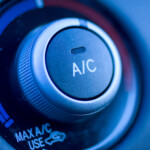Vehicle Air Conditioner Servicing and Disposal
Stay compliant and avoid violations regarding the servicing and disposal of Vehicle Air Conditioners.
 Motor Vehicle Air Conditioning (MVAC) equipment uses refrigeration to cool the compartment of vehicles. These MVAC units and other refrigerating equipment contain various chemicals (e.g., chlorofluorocarbon (CFC)-12 and hydrofluorocarbon (HFC)-134a) that can destroy the earth’s protective ozone layer and contribute to climate change. Under section 609 of the Clean Air Act, these refrigerants must be captured and not knowingly released into the environment.
Motor Vehicle Air Conditioning (MVAC) equipment uses refrigeration to cool the compartment of vehicles. These MVAC units and other refrigerating equipment contain various chemicals (e.g., chlorofluorocarbon (CFC)-12 and hydrofluorocarbon (HFC)-134a) that can destroy the earth’s protective ozone layer and contribute to climate change. Under section 609 of the Clean Air Act, these refrigerants must be captured and not knowingly released into the environment.
Regulatory Requirements for Servicing MVAC Systems
• Technicians must always use EPA-approved refrigerant and refrigerant handling and/or recycling equipment.
• Certification is also a requirement for all individuals servicing any MVAC system.
• Refrigerants must be properly recycled or reclaimed before it can be reused, even if it is being returned to the vehicle from which it was removed.
• Prevent the mixing of refrigerants and use containers with unique fitting for each refrigerant.
• Sell refrigerants made of (CFC)-12 and (HFC)-134a to only certified technicians, buyers that employ at least one certified technician, certified wholesalers, or appliance manufacturers for eventual resale.
Recordkeeping Requirements and Sales Restrictions for Service Shops
• First time auto body shops servicing MVAC systems must certify to their EPA regional office that they are properly using approved refrigerant handling equipment.
• To certify your equipment, provide a written statement signed by the person who acquired the equipment and send your signed certification statement to the EPA regional office.
• Keep records of technician training and certification on-site for three years, including the address of any facility to which recovered refrigerant was sent.
• Sellers of refrigerants must display a sign where sales occur stating the certification requirements for purchasers. Additional information can be found here: epa.gov/mvac/epa-regulatory-requirements-mvac-system-servicing.
Management and Disposal of MVAC Refrigerants
MVAC systems typically enter the waste stream with their refrigerant charge intact. When that happens, the final person in the disposal chain must remove the refrigerant or ensure their customer has removed it prior to disposal. Before disposal of an MVAC or MVAC-like appliances (e.g., contained in cars and trucks):
• Remove the non-exempt refrigerant from the appliance and reduce the system pressure to below 102 mm of mercury vacuum.
• The equipment used to recover refrigerant from appliances prior to their final disposal must meet the same performance standards as refrigerant recovery equipment used for servicing.
• Refrigerants must be recovered from air-conditioning equipment dismantled on-site before disposal.
• Refrigerant in self-sealing “small cans” containing less than two pounds of refrigerant are exempt from this sales restriction and any reporting requirements.
• Anyone selling refrigerant must verify that the buyer is properly certified and must post a sign that explains the sales restrictions.
• Appliance disposal and recycling facilities must keep a copy of all the signed statements or contracts indicating non-exempt refrigerant was recovered properly from appliances. Records should be maintained for three years.
• Keep records of individuals who recovered refrigerants and the date the refrigerant was recovered along with signed contracts between the disposal facilities and suppliers certifying that the refrigerant had been previously properly recovered.
MVAC Servicing Best Practices
• Locate and repair leaks before topping off a system and do not add more refrigerant than necessary.
• Never mix refrigerants or use a refrigerant not intended for an MVAC system. Mixing refrigerants causes hazards to human health and the environment.
• Consider purchasing certified refrigerant identification equipment.
• Comply with all specifications on refrigerant containers, vehicle manufacturers’ manuals, and lubricants, and avoid replacing MVAC system components with salvaged parts or parts meant for another refrigerant.
• Avoid sparks or flames in the work area and wear safety glasses and insulated gloves.
• Ensure there is no direct contact of refrigerant with skin and work in a well-ventilated area.
What You Need to Know:
EPA’s Significant New Alternatives Policy (SNAP) Program has introduced a transition to three low global warming potential (GWP) climate friendly MVAC refrigerants under the Significant New Alternatives Policy (SNAP) Program. The hydrofluoroolefin (HFO)-1234yf, carbon dioxide, and (HFC)-152a poses lower risk to public health and the environment, does not deplete the ozone layer and all have significantly lower impacts to the climate system than (CFC)-12 and (HFC)-134a.
As of 2012, automobile manufacturers began the transition to new climate friendly GWP alternatives. It is important for both consumers and technicians to be aware of these alternative refrigerants, their properties and proper servicing procedures.
EPA has a fact sheet with more details on (MVAC) System Servicing at: epa.gov/mvac or visit the MPCA webpage -working with refrigerants at:.pca.state.mn.us/business-with-us/working-wit-refigerants. You can also contact the MPCA Small Business Environmental Assistance Program for confidential assistance on regulatory matters at (651) 282-6143 or e-mail smallbizhelp.pca@state.mn.us.
Want more? Check out the May 2023 issue of AASP-MN News!
